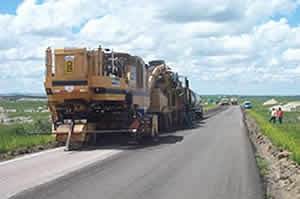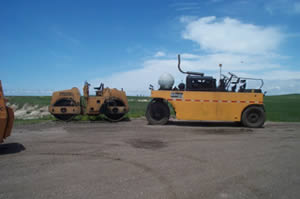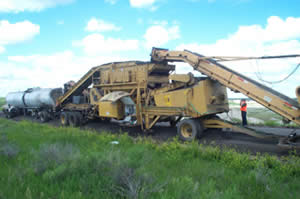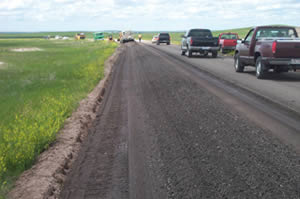U.S. Department of Transportation
Federal Highway Administration
1200 New Jersey Avenue, SE
Washington, DC 20590
202-366-4000
Focus
| Accelerating Infrastructure Innovations |
Publication Number: FHWA-RD-01-068
Date: October 2001
For the Federal Highway Administration's (FHWA) Central Federal Lands office, cold in-place recycling (CIR) of asphalt pavements has proven to be a viable method of rehabilitating roads that both minimizes user delay and is more environmentally sustainable. In June 2001, a group of engineers from the North Dakota Department of Transportation (DOT) and FHWA visited a CIR project in the Badlands National Park in South Dakota to learn more about the methods Central Federal Lands uses to select, design, and construct CIR projects. The site visit was designed to help the North Dakota DOT engineers determine if CIR could be a cost-effective method of rehabilitating some of North Dakota's low volume roads.
CIR is performed by milling, screening, and crushing existing asphalt pavement. An asphalt rejuvenator, usually in the form of an emulsion, is then blended with the asphalt and the material is laid back down to form a new pavement structure. A new surface consisting of hot-mix asphalt (HMA) or a seal coat is also usually applied.
The road to be rehabilitated in the Badlands consisted of two 3.6-m (12-ft) lanes with no shoulders and 7.6 cm (3-in) of asphalt pavement with a 25-cm (10-in) aggregate base. As part of the reconstruction, the road was being widened by 1.2 m (4-ft) to provide .6-m (2-ft) shoulders on each side of the roadway. The plan called for 7.6 cm (3-in) of new hot bituminous pavement to be placed on top of the recycled roadway.
To determine if CIR is a viable rehabilitation strategy, Central Federal Lands assesses the physical condition of the pavement, traffic volume at the site, and material characteristics of the existing soils, base, and aged HMA. CIR does not improve the underlying soils, so if the pavement is rutting because of problems in the subgrade, CIR is not a viable rehabilitation option. CIR is also usually not performed on projects that are less than 4.8 km (3 mi) in length because of the mobilization costs. And generally, Central Federal Lands does not perform CIR on projects with traffic volumes higher than an annual average daily traffic of 3000.
On the first day of the project, the contractor began by milling the full 7.6 cm (3 in) of HMA. However, the remaining soil and base structure was unable to support the weight of the equipment, so the contractor decided to perform CIR on 6.35 cm (2.5 in) of the remaining portion of the project to eliminate the problem. After milling, the asphalt was screened and crushed. The material was then mixed with emulsion. For this project, High Float Emulsion HFMS-2s was used as the recycling agent. Field adjustments were then made to the recycling agent to achieve adequate mixture properties.
During the CIR process, the paving machine had to stay far enough behind the recycling train to allow for some of the moisture in the mix to evaporate prior to being laid down by the paving machine. The amount of water in the recycled asphalt pavement is critical to achieving adequate density.
The compaction was performed by a 30-ton pneumatic roller, followed by a double-drum steel wheel roller. Traffic was allowed back on the roadway about 2 hours later.
"I thought the demonstration was very useful," says Ron Tessier of North Dakota DOT. "There were a lot of questions I had about cold in-place recycling and those were answered. I think that we have a project that it could be used on."
"CIR appears to be working well for Central Federal Lands," says Carl Ramos of FHWA. The major advantages of this rehabilitation method are retardation of reflective cracking, reduction in the use of virgin aggregates, and less disruption of traffic due to the quick progression of work. Use of the method can also add years to the expected service life of the pavement and lower life-cycle costs. Local agencies in Iowa and the Iowa DOT, which uses CIR on about a dozen projects a year, have found that it adds 2-4 years of life to the pavement by retarding or eliminating reflective cracking.
After 10 years of experience with the method, says Ramos, "we have found that the keys to success are appropriate project selection, adequate design, and quality construction by both the contracting agency and the contractor."
For more information, contact Carl Ramos at the Central Federal Lands office, 701-250-4345 (email: carl.ramos@fhwa.dot.gov).
 |  |
 |  |
Two 3.6-m (12-ft) lanes were rehabilitated in the Badlands National Park using cold in-place recycling. |
|